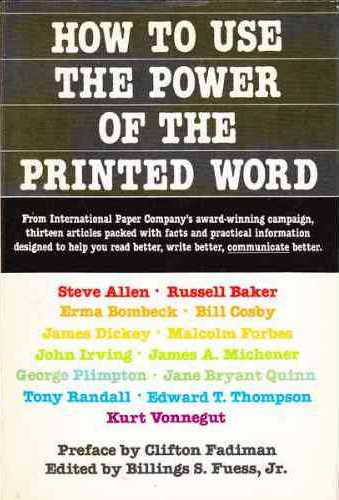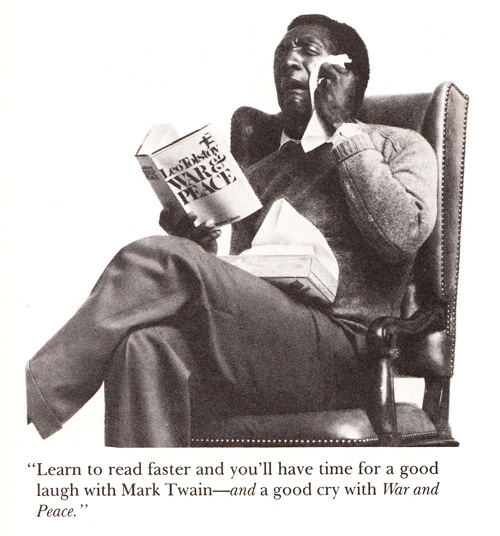“Nobody gets something for nothing in the reading game.â€
 “All attempts at gaining literary polish must begin with judicious reading, H. P. Lovecraft famously advised aspiring writers. Indeed, reading is an essential skill on par with writing, and though non-reading may be an intellectual choice on par with reading, reading itself â€" just like writing â€" is a craft that requires optimal technique for optimal outcome. So how, exactly, do we hone that vital technique? While speed-reading tutorials, courses, software, and books abound today, some of the most potent tips you’ll ever receive come from an unexpected source:
“All attempts at gaining literary polish must begin with judicious reading, H. P. Lovecraft famously advised aspiring writers. Indeed, reading is an essential skill on par with writing, and though non-reading may be an intellectual choice on par with reading, reading itself â€" just like writing â€" is a craft that requires optimal technique for optimal outcome. So how, exactly, do we hone that vital technique? While speed-reading tutorials, courses, software, and books abound today, some of the most potent tips you’ll ever receive come from an unexpected source:
Bill Cosby may be best-known as the beloved personality behind his eponymous TV show, but he earned his doctorate in education and has been involved in several projects teaching the essential techniques of effective reading, including a PBS series on reading skills. In an essay unambiguously titled “How to Read Faster,†published in the same wonderful 1985 anthology How to Use the Power of the Printed Word (UK; public library) that gave us Kurt Vonnegut’s 8 timeless rules of writing, Cosby offers his three proven strategies for reading faster. Apart from their evergreen application to the printed word, it’s particularly interesting to consider how these rules might translate to the digital screen, where structural factors like scrolling, pagination, hyperlinks, and adjustable font sizes make the text and the reading experience at once more fluid and more rigid.
1. Preview â€" If It’s Long and Hard
Previewing is especially useful for getting a general idea of heavy reading like long magazine or newspaper articles, business reports, and nonfiction books.
It can give you as much as half the comprehension in as little as one tenth the time. For example, you should be able to preview eight or ten 100-page reports in an hour. After previewing, you’ll be able to decide which reports (or which parts of which reports) are worth a closer look.
Here’s how to preview: Read the entire first two paragraphs of whatever you’ve chosen. Next read only the first sentence of each successive paragraph. Then read the entire last two paragraphs.
Previewing doesn’t give you all the details. But it does keep you from spending time on things you don’t really want â€" or need â€" to read.
Notice that previewing gives you a quick, overall view of long, unfamiliar material. For short, light reading, there’s a better technique.
2. Skim â€" If It’s Short and Simple
Skimming is a good way to get a general idea of light reading such as popular magazines or the sports and entertainment sections of the paper.
You should be able to skim a weekly popular magazine or the second section of your daily paper in less than half the time it takes you to read it now.
Skimming is also a great way to review material you’ve read before.
Here’s how to skim: Think of your eyes as magnets. Force them to move fast. Sweep them across each and every line of type. Pick up only a few key words in each line.
Everybody skims differently.
You and I may not pick up exactly the same words when we skim the same piece, but we’ll both get a pretty similar idea of what it’s all about.
To show you how it works, I circled the words I picked out when I skimmed the following story. Try it. It shouldn’t take you more than ten seconds.
Skimming can give you a very good idea of this story in about half the words, and in less than half the time it’d take to read every word.
So far, you’ve seen that previewing and skimming can give you a general idea about content â€" fast. But neither technique can promise more than 50 percent comprehension, because you aren’t reading all the words. (Nobody gets something for nothing in the reading game.)
To read faster and understand most, if not all, of what you read, you need to know a third technique.
3. Cluster â€" to Increase Speed AND Comprehension
Most of us learn to read by looking at each word in a sentence â€" one at a time.
Like this:
My â€" brother â€" Russell â€" thinks â€" monsters…
You probably still read this way sometimes, especially when the words are difficult. Or when the words have an extraspecial meaning, as in a poem, a Shakespeare play or a contract. And that’s okay.
But word-by-word reading is a rotten way to read faster. It actually cuts down on your speed.
Clustering trains you to look at groups of words instead of one at a time, and it increases your speed enormously. For most of us, clustering is a totally different way of seeing what we read.
Here’s how to cluster: Train your eyes to see all the words in clusters of up to three or four words at a glance.
Here’s how I’d cluster the story we just skimmed:
Learning to read clusters is not something your eyes do naturally. It takes constant practice.
Here’s how to go about it: Pick something light to read. Read it as fast as you can. Concentrate on seeing three to four words at once rather than one word at a time. Then reread the piece at your normal speed to see what you missed the first time.
Try a second piece. First cluster, then reread to see what you missed in this one.
When you can read in clusters without missing much the first time, your speed has increased. Practice fifteen minutes every day and you might pick up the technique in a week or so. (But don’t be disappointed if it takes longer. Clustering everything takes time and practice.
How to Use the Power of the Printed Word is a treasure trove of illuminating essays â€" highly recommended.
Donating = Loving
In 2012, bringing you (ad-free) Brain Pickings took more than 5,000 hours. If you found any joy and stimulation here this year, please consider becoming a Member and supporting with a recurring monthly donation of your choosing, between a cup of coffee and a fancy dinner:
You can also become a one-time patron with a single donation in any amount:





No comments:
Post a Comment